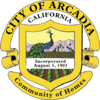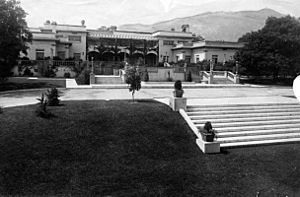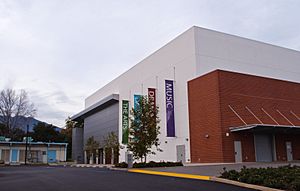Arcadia, California facts for kids
Quick facts for kids
Arcadia, California
|
|||
|---|---|---|---|
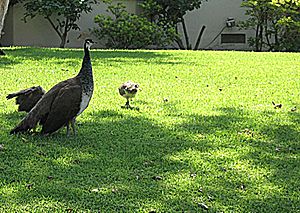
Peafowl, a symbol of Arcadia, walking on a lawn in Arcadia
|
|||
|
|||
| Motto(s):
Community of Homes
|
|||
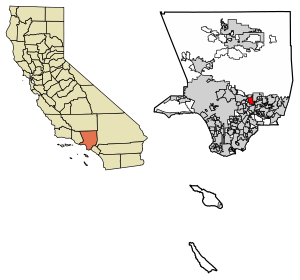
Location of Arcadia in Los Angeles County, California
|
|||
| Country | United States | ||
| State | California | ||
| County | Los Angeles | ||
| Incorporated | August 5, 1903 | ||
| Named for | Arcadia | ||
| Government | |||
| • Type | Council–manager | ||
| Area | |||
| • Total | 11.14 sq mi (28.84 km2) | ||
| • Land | 10.93 sq mi (28.30 km2) | ||
| • Water | 0.21 sq mi (0.54 km2) 1.87% | ||
| Elevation | 482 ft (147 m) | ||
| Population
(2020)
|
|||
| • Total | 56,681 | ||
| • Density | 5,187.24/sq mi (2,002.81/km2) | ||
| Time zone | UTC−8 (Pacific) | ||
| • Summer (DST) | UTC−7 (PDT) | ||
| ZIP Codes |
91006–91007, 91066, 91077
|
||
| Area code | 626 | ||
| FIPS code | 06-02462 | ||
| GNIS feature IDs | 1652664, 2409722 | ||
Arcadia is a city in Los Angeles County, California, United States. It is about 13 miles (21 km) northeast of downtown Los Angeles. The city is in the San Gabriel Valley, at the base of the San Gabriel Mountains. Arcadia is known for its parks, including the Santa Anita Park racetrack and the Los Angeles County Arboretum and Botanic Garden. In 2020, about 56,681 people lived there. The city's name comes from Arcadia, a region in Greece.
Contents
History of Arcadia
Early Native American Life
For over 8,000 years, the land where Arcadia is now was home to the Tongva people. This Native American tribe lived across the greater Los Angeles Basin. Their territory included the San Gabriel and San Fernando Valleys. A Tongva village in what is now Arcadia was called Alyeupkigna.
Spanish and Mexican Ranchos
In 1771, the area became part of the Spanish Mission San Gabriel Arcángel lands. The Tongva people were later called Gabrieliños after the Mission.
Later, in 1845, the land became a Mexican land grant called Rancho Santa Anita. It was given to Perfecto Hugo Reid and his Tongva wife, Victoria Bartolomea Comicrabit. Hugo Reid wrote about the Gabrieliño Native Americans. In 1847, Reid sold the Rancho Santa Anita to Henry Dalton.
Lucky Baldwin's Influence
The rancho changed hands several times. In 1875, a wealthy businessman named Elias Jackson "Lucky" Baldwin bought 8,000 acres (3,200 ha) of Rancho Santa Anita. He paid $200,000 for it. Baldwin loved the area and decided to make it his home. He started building and farming the land right away.
Baldwin built the beautiful Queen Anne Cottage in 1885–1886. You can still see it today at the Arboretum. In 1885, a railroad line opened through the ranch. This made it easier to divide the land into a town. Baldwin also opened the Hotel Oakwood in 1889. The Rancho Santa Anita Depot was built in 1890.
Arcadia in the Early 1900s
By 1900, Arcadia had about 500 people. Its economy started to focus on entertainment and sports, including an early version of the Santa Anita race track. Lucky Baldwin helped Arcadia become an official city in 1903. He was also its first mayor.
The Anoakia Mansion
In 1913, Anita Baldwin, Lucky's daughter, built a large mansion. It had 50 rooms and was on 19 acres (7.7 ha) of land. She named it "Anoakia," combining her name with the many oak trees there. The mansion was built in the Italian Renaissance Revival style. It had beautiful gardens and other buildings like a bathhouse. The estate also kept the native oak trees.
After Anita Baldwin passed away, the estate became a school. Later, the mansion and other buildings were taken down in 2000 to make way for new homes. Some parts of the mansion were saved. The gatehouse and outer walls still remain today.
Between the World Wars
During World War I, Arcadia was home to the U.S. Army's Ross Field Balloon School. Soldiers learned to observe enemy activity from hot air balloons here. This school was located at the present-day Santa Anita Park site.
After World War I, Arcadia grew. Many chicken farms and other farms were here. In the 1920s and 1930s, Arcadia started to become a residential city. Small farms were replaced by homes. New buildings like a city library and city hall were built. The city was also on historic U.S. Route 66.
Thoroughbred horse racing came back to Arcadia when Santa Anita Park opened in December 1934. The buildings were designed in a mix of Colonial Revival and Streamline Moderne styles.
Santa Anita Assembly Center
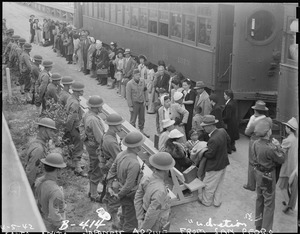
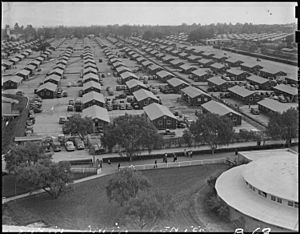
During World War II in 1942, the Santa Anita racetrack was used as a temporary holding site. This was for Japanese Americans who were forced to leave their homes. They were moved as part of a government order. The Santa Anita Assembly Center was the largest of these sites. More than 18,000 people lived there in simple conditions. Many lived in temporary barracks or converted horse stalls. They stayed there from March to October 1942. Then, they were moved to larger, more permanent camps in other states.
After this, the site was used by the U.S. Army for training. Later, it became a camp for prisoners of war during the war.
Post-War Growth
After World War II, Arcadia grew quickly. It became a popular suburb of nearby Pasadena. Many chicken farms were divided into lots for new homes. Between 1940 and 1950, the population more than doubled. This growth continued through the 1950s and 1960s. New schools, shops, and city services were added.
A modern shopping area developed along Baldwin Avenue. In 1951, Hinshaw's department store opened there. This made Arcadia an important shopping area in the San Gabriel Valley.
In 1947, 111 acres (45 ha) of the original Baldwin Ranch became the Los Angeles County Arboretum and Botanic Garden.
In 1975, the Santa Anita Fashion Park opened. This mall expanded in 2004 and is now called Westfield Santa Anita.
In the 1980s, more people of Asian descent began to move to Arcadia. By 2010, Asians made up 59.2% of the population.
Geography
Arcadia has a total area of 11.1 square miles (28.8 km2). Most of this is land, about 10.9 square miles (28.3 km2). A small part, 0.2 square miles (0.54 km2), is water.
Population and Homes
Arcadia is known for its expensive homes. In 2016, it was ranked the fifth most expensive housing market in the U.S. The average price for a four-bedroom home was about $1,748,680.
In 2014, the Upper Rancho neighborhood in Arcadia was ranked as one of the richest in Southern California. The average household income there was $310,779.
| Historical population | |||
|---|---|---|---|
| Census | Pop. | %± | |
| 1910 | 696 | — | |
| 1920 | 2,239 | 221.7% | |
| 1930 | 5,216 | 133.0% | |
| 1940 | 9,122 | 74.9% | |
| 1950 | 23,066 | 152.9% | |
| 1960 | 41,005 | 77.8% | |
| 1970 | 45,138 | 10.1% | |
| 1980 | 45,993 | 1.9% | |
| 1990 | 48,290 | 5.0% | |
| 2000 | 53,054 | 9.9% | |
| 2010 | 56,364 | 6.2% | |
| 2020 | 56,681 | 0.6% | |
| U.S. Decennial Census | |||
Population in 2020
The 2020 Census showed that Arcadia had 56,681 people. About 64.9% of the population was Asian. White people made up 20.1%. About 13.1% of the population was Hispanic or Latino.
Most homes in Arcadia are occupied, with 94.5% of housing units lived in. About 58.7% of these homes are owned by the people living in them. The rest are rented.
The average household income between 2017 and 2021 was $99,588. Most households (96.7%) had a computer. Also, 94.0% had a broadband internet connection.
Population in 2010
In 2010, Arcadia's population was 56,364. About 59.2% of the people were Asian. White people made up 32.3%. Hispanic or Latino people were 12.1% of the population.
There were 19,592 households in 2010. About 37.4% of these had children under 18. The average household size was 2.83 people.
The median age in Arcadia was 43.1 years. About 21.8% of the people were under 18. And 16.3% were 65 years or older.
These were the ten neighborhoods in Los Angeles County with the largest percentage of Asian residents, according to the 2000 census:
- Chinatown, 70.6%
- Monterey Park, 61.1%
- Cerritos, 58.3%
- Walnut, 56.2%
- Rowland Heights, 51.7%
- San Gabriel, 48.9%
- Rosemead, 48.6%
- Alhambra, 47.2%
- San Marino, 46.8%
- Arcadia, 45.4%
Economy and Shopping
Arcadia's economy relies on wholesale and retail trade. It also includes manufacturing, healthcare, and entertainment. Money from the Santa Anita Racetrack has helped the city improve over the years.
The Westfield Santa Anita mall is a big shopping center. In 2005, it added a new food court and more stores. In 2008, it expanded again with new high-end shops.
There were plans for another large shopping mall next to Westfield Santa Anita. This project was called "The Shops at Santa Anita." It would have made Arcadia one of the biggest shopping areas in Los Angeles County. However, the plans were stopped in 2011.
Main Employers
Here are some of the top private employers in Arcadia, based on a 2020 report:
| # | Employer | # of Employees |
|---|---|---|
| 1 | Macy's West | 443 |
| 2 | Nordstrom Inc. | 417 |
| 3 | FedEx Ground Package System, Inc. | 389 |
| 4 | Optum | 205 |
| 5 | J C Penney Corp, Inc. | 204 |
| 6 | The Cheesecake Factory Restaurants, Inc. | 180 |
| 7 | Dave & Buster's | 165 |
| 8 | Din Tai Fung | 135 |
| 9 | Vons | 128 |
| 9 | 99 Ranch Market | 128 |
Things to See and Do
The Los Angeles County Arboretum and Botanic Garden is a popular place to visit. It is across from the Santa Anita mall and racetrack. Many peafowl (peacocks and peahens) roam freely there and in nearby neighborhoods. These birds are descendants of those brought by Lucky Baldwin. He used them to help control snakes and snails on his farm. Some people love seeing the peafowl, while others find them noisy.
Education in Arcadia
The Arcadia Unified School District serves the city's students. Reading scores for the district are much higher than the state average. Math scores are also significantly higher. About 88% of Arcadia students go to public schools.
Arcadia has one highly-rated high school, Arcadia High School. It is known for its strong academic performance. The district also has three middle schools and six elementary schools. Two of the elementary schools have won the Blue Ribbon Schools award. This award recognizes schools for their excellent academic programs.
In 2010, BusinessWeek magazine named Arcadia the best place to raise children in California. They noted the city's great schools and low crime rate.
Elementary Schools
- Baldwin Stocker Elementary
- Camino Grove Elementary
- Highland Oaks Elementary
- Holly Avenue Elementary
- Longley Way Elementary
- Reid (Hugo) Elementary
Middle Schools
- Dana (Richard Henry) Middle
- First Avenue Middle
- Foothills Middle
High School
- Arcadia High School
Arcadia High School has a high Academic Performance Index score of 890. This makes it one of the top-performing large high schools in California. In 2010, 29 students from Arcadia High were National Merit Award finalists. The school's boys cross-country team also won national championships in 2010 and 2012.
City Services
Police and Fire Departments
The Arcadia Police Department and Arcadia Fire Department keep the city safe. In recent years, both departments have hired their first Asian American Chiefs. Roy Nakamura became Police Chief in 2021, and Chen Suen became Fire Chief in 2022.
Transportation
Arcadia has several main roads. Major east-west streets include Foothill Boulevard and Huntington Drive. Key north-south streets are Baldwin Avenue and Santa Anita Avenue. The city is also served by the Foothill Freeway (I-210).
Arcadia Transit
The city of Arcadia has its own bus services. It offers three regular bus routes. There is also a Dial-A-Ride service. This provides door-to-door rides within the city.
Metro A Line
In 2016, Metro opened a new light rail station in Arcadia. The Arcadia Station is served by the Metro A Line. This train line connects Arcadia to other parts of Los Angeles County.
Healthcare
USC Arcadia Hospital, located at 300 W. Huntington Drive, is a large hospital in the city. It has 460 beds and opened in Arcadia in 1957. It was the first community hospital in California to have a psychiatric unit. It was also an official hospital for the 1984 Summer Olympics.
The hospital has been updated over the years. A new patient tower and emergency department opened in 2011.
Methodist Hospital School of Nursing
A School of Nursing opened at the hospital in 1915. It trained many nurses over the years. The school closed in 1958. This was because nursing education began to move into colleges and universities.
Water and Sewer Services
The City of Arcadia provides water and sewer services to its residents. The city gets its water from underground sources. These sources are refilled by local rainwater and water brought in from other places.
Notable People from Arcadia
Many interesting people have connections to Arcadia:
- Michael Anthony, bassist for the band Van Halen
- Tracy Caldwell Dyson, astronaut
- Jimmy Conrad, former soccer player
- Sven Davidson, tennis player who won the French Open and Wimbledon
- John Grabow, major league baseball pitcher
- Phil Hendrie, radio personality
- Colleen Kay Hutchins, Miss America 1952
- Jet Li, international film star and martial artist
- Mirai Nagasu, Olympic figure skater
- Lindsay Price, actress
- Jason Robertson, professional hockey player
- Nick Robertson, professional hockey player
- Mark Tuan, member of the K-pop group GOT7
- Wil Wheaton, actor from Star Trek: The Next Generation
- George Woolf, famous horse jockey
Sister City
Arcadia has one sister city: Newcastle, Australia. You can find Newcastle Park on Colorado Boulevard in Arcadia. There is also an Arcadia Park in Newcastle, Australia.
Images for kids
-
U.S. Army's Ross Field Balloon School hangars
See also
 In Spanish: Arcadia (California) para niños
In Spanish: Arcadia (California) para niños



